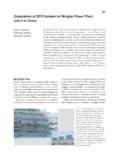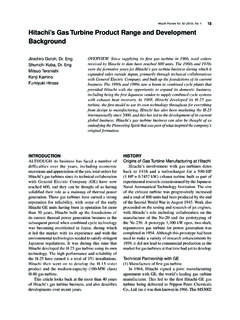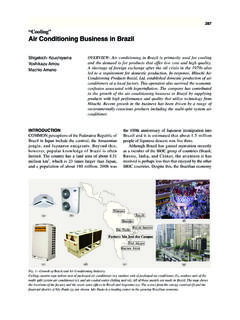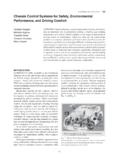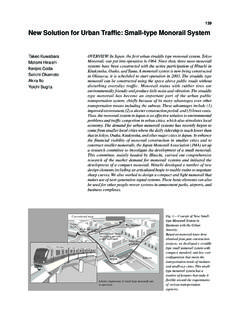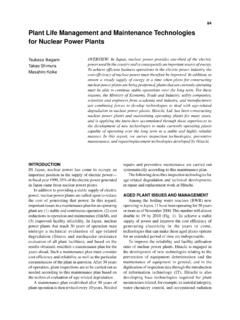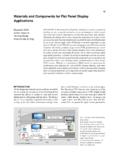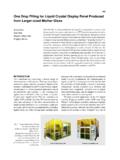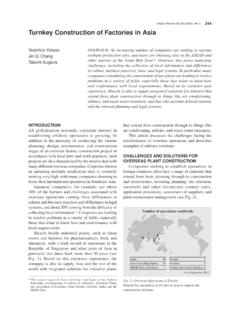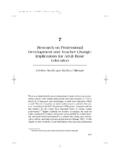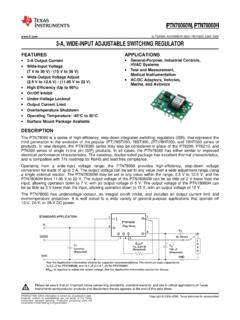Transcription of DeNOx, DeSOx, and CO2 Removal Technology for Power …
1 DeNOx, desox , and CO2 Removal Technology for Power Plant 174. DeNOx, desox , and CO2 Removal Technology for Power Plant Hirofumi Kikkawa, Dr. Eng. OVERVIEW: Flue gas generated when fossil fuels like coal are burned in Hiroshi Ishizaka thermal Power plants contains constituents that are potential causes of global warming and acid rain. Moreover, it affects the environment of not only the Keiichiro Kai home country where it was discharged but also the whole world at large. Takanori Nakamoto Babcock-Hitachi is developing Technology for reducing NOx generated when coal is burned in thermal Power plants to the minimum possible level as well as developing Technology for efficiently removing the generated NOx, SOx, and so on. Furthermore, in regard to CO2, we are continuing to develop CO2 Removal Technology that can be applied at coal-fired Power plants .
2 Exploiting these flue-gas treatment technologies, we will continue to build on our already substantial accomplishments and, in cooperation with Hitachi Group companies outside Japan as well as in Japan, we will contribute significantly to environmental preservation through licensing of our Technology and exporting our products. INTRODUCTION Hitachi has developed and commercialized flue- IN regard to thermal Power plants , NOx (oxides of gas treatment Technology for highly efficient nitrogen) and SOx (oxides of sulfur) which are elimination of NOx and SOx from flue gas. generated when coal or heavy oils are burned are Furthermore, in regard to CO2 (carbon dioxide), causative agents that cause atmospheric pollution. which is one of the substances contributing to global From the viewpoint of controlling this pollution, warming, we have developed a system for absorbing purification processing on these agents is thus and recovering CO2 from flue gas by means of a unique imperative.
3 As a world leader in the field, Babcock- amino solvent, and in collaboration with Tokyo Electric Desulphurization tower DESP NOx- Removal GGH. Fig. 1 External View of New Flue- catalyst GGH (heat-recovery side). gas Treatment System Applied at (reheating side). Tachibanawan Power Station Unit 2 of Electric Power Development Co., Ltd. At Babcock-Hitachi , we are contributing to environmental protection all over the world through development and practical application of new flue-gas treatment systems for efficiently cleaning up flue gas from GGH: gas-gas heat exchanger thermal- Power -plant boilers. DESP: dry electrostatic precipitator Hitachi Review Vol. 57 (2008), No. 5 175. Power Co., Inc. (TEPCO), we confirmed that this system (installed at a pilot plant using flue gas from Boiler Stack actual equipment of TEPCO's Yokosuka Thermal NOx- Removal Desulphurization equipment GGH equipment Power Station) attained high CO 2 -elimination (heat recovery) GGH.
4 (reheating). performance(1). DESP. In this way, targeting realization of a clean environment, Babcock-Hitachi is advancing the development of cutting-edge flue-gas treatment A/H. Technology . In the rest of this report, development achievements and future undertakings in regard to a A/H: air heater NOx Removal catalyst, a wet desulphurization unit, and CO2-recovery Technology installed at a coal-fired Fig. 2 Process Flow of New Flue-gas Treatment System. thermal Power plant are described as some typical By means of the GGH, the gas temperature at the DESP is examples of this Technology . lowered, and dust- Removal performance is improved. REGULATORY TRENDS AND FLUE-GAS. TREATMENT SYSTEMS lowering the gas-emission temperature at the inlet of As for thermal Power plants in Japan, in accordance the DESP (dry electrostatic precipitator) by the GGH.
5 With the strengthening of environmental regulations (gas-gas heat exchanger). The first units applying these that started in the 1970s, world-leading flue-gas methods have been installed at Tachibanawan Power treatment Technology [such as NOx reduction and Station Unit 2 (1,050 MW) of Electric Power desulphurization ( desox ) systems] has been applied Development Co., Ltd. (see Fig. 1) and are attaining and, today, this Technology represents the top high efficiency(3). technological level in the world. Flue-gas treatment An example of the process flow of a current flue- Technology accumulated by Babcock-Hitachi gas treatment system is shown in Fig. 2. This system over many years is making a contribution to this field was considered as an effective countermeasure against in the form of licensed Technology and product exports SO3 (sulphuric-acid mist) in case of coal from the in cooperation with Hitachi Group companies not only eastern part of the USA (which contains a lot more in Japan but around the world as well.)
6 In the United sulfur than coal used in Japan and is hereafter referred States, regulations on concentration of PM (particulate to as eastern bituminous high-S coal ), and its material) as well as on NOx and SO x are being excellent performance was confirmed by means of strengthened in a stepwise fashion(2), and the need for verification testing on equipment in the USA(4). In flue-gas treatment Technology continues to grow. addition, to handle a wide variety of coals from around Moreover, the quality of coal used for thermal Power generation in the USA is lower than that used in Japan;. Combustion system as a result, it is often the case that higher purification performance than that needed in Japan is necessary in Flue-gas treatment system the USA. Such advanced flue-gas treatment Technology is also considered useful in the case that lower quality coal is used in Japan in the future.
7 In the meantime, with the absorption of new members into the European Union (EU), the need for environmentally friendly plants , particularly in regions where environmental measures are insufficient (namely, countries of Eastern Europe), is growing stronger. As for flue-gas treatment Technology , it is important Control room to not only improve the performance of individual Fig. 3 Test Plant of Total System for Combustion and Flue-gas pieces of equipment in a system but also to raise the Treatment (2,000 Nm3/h). Removal efficiency of the entire flue-gas treatment Flue-gas-treatment characteristics when burning coal from system. For example, in regard to PM Removal , it is various countries of the world are evaluated and reflected in the effective to improve soot- Removal efficiency by design. DeNOx, desox , and CO2 Removal Technology for Power Plant 176.
8 The world with different characteristics, development high, and part of that is oxidized by NOx- Removal with the use of a test plant for a total system for catalyst to generate SO3, which is becoming a major combustion and flue-gas treatment on which various problem in plume. To address that problem, a new pieces of flue-gas treatment equipment are installed catalyst whose SO2 oxidation rate was lowered under is continuing (see Fig. 3). a fifth of a conventional one was developed through improvements in catalyst composition(7). As a world's DENOx CATALYST first, this catalyst has been applied at a plant fired with Characteristics of Plate Catalyst eastern bituminous high-S coal. When coal is burned in a boiler, part of the nitrogen What's more, through application of contained in the coal and air reacts with oxygen and nanotechnology, development of groundbreaking NOx- NOx is generated.
9 At Babcock-Hitachi , we have Removal Technology , such as high-performance established and practically applied a new concept catalysts (whose performance reduction is only small called NOx reduction in flame namely, breaking despite the presence of constituents in the flue gas that down NOx efficiently by controlling combustion reduce the catalyst performance), is continuing. conditions in a flame(5). Moreover, we are currently developing a Technology for reducing the concentration DESULPHURIZATION SYSTEM. of NO x emitted from a boiler (6) . With these Basic Principle technologies, it is possible to reduce the concentration Using limestone (which is available cheaply around of NOx to a certain level without the use of a catalyst; the world), the limestone-gypsum process performs however, to reduce NOx concentration below that level, desulphurization by eliminating hazardous SO2 from a catalyst and ammonia which is used as a reducing flue gas.
10 After SO2 is absorbed and reacts with the agent are required. limestone, gypsum is generated by oxidization (see With the catalyst developed by Babcock-Hitachi, Fig. 5). The generated gypsum can then be effectively which has a plate form as shown in Fig. 4, few utilized as a raw material for cement or plasterboard. blockages and little wear due to ash occur, and it is Babcock-Hitachi has been performing absorption expected to provide high performance over a long and oxidation of SO2 in a single absorber tower (a lifetime. As a result, it achieves high reliability in use process conventionally done in separate absorbers), in coal-fired Power plants in the world, and currently and first practically applied an in-situ forced-oxidation holds a 30% share of the world market for NOx- Removal catalysts. Exhaust High Functionality (Low SO2 Oxidation Catalyst) gas Flue gas generated when coal is burned contains SO2 (sulfur-dioxide) gas at a concentration of several Spray Mist eliminator nozzle hundred to a several thousand ppm (parts per million).
